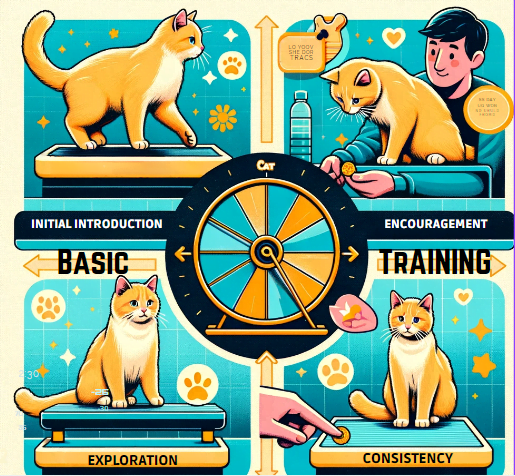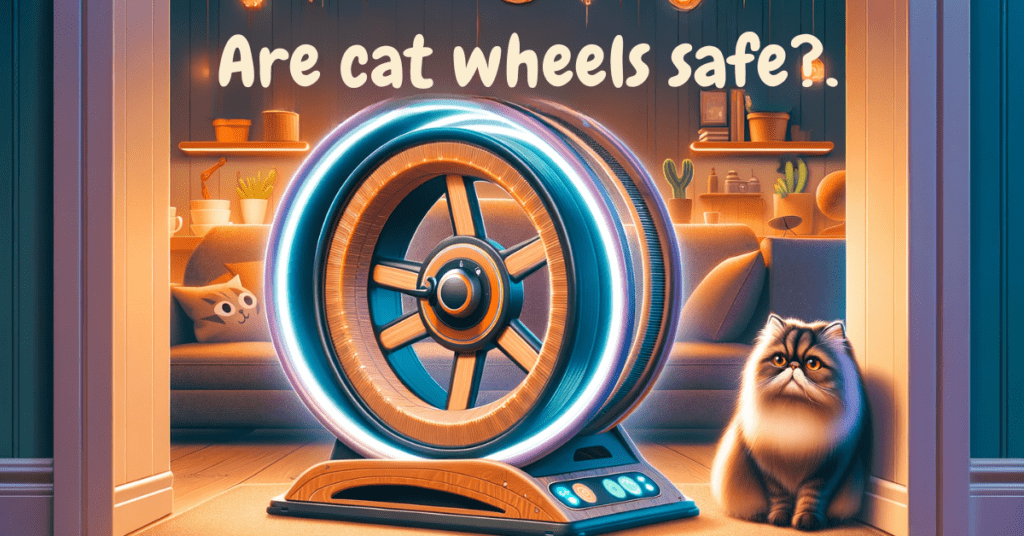This post contains affiliate links and I will be compensated if you make a purchase after clicking on my links.
Beginner’s Guide to Cat Wheel Training: From Curious Cat to Racing Pro
Cat Wheel Training is not merely a trend, it’s a stride towards happier, healthier kitties. But how do you transition from curious cat to wheel-racing whiz? How do you ignite that zest for the zestful spin in your feline friend?
This is the core of our whiskered wonder today: How to get your cat racing on the wheel with glee and gusto.
In this Cat Wheel Training 101 guide, we’ll dash through the mechanics of the cat wheel, trot along the trail of training techniques, and sprint towards achieving that satisfying spin. It’s about turning the ‘meow’ into ‘vroom,’ and getting those paws racing on the wheel with a blend of patience, practice, and a sprinkle of tech magic.
Cat Wheel Training: Key Takeaways
For those on a tight schedule, these key takeaways offer a swift glimpse into the essentials of cat wheel training. If you’re after the quick scoop, here it is — for an in-depth exploration, leap into the full article when time allows.
Understanding the Cat Wheel: A cat wheel is a device that allows indoor cats to exercise by walking or running, designed to engage cats and promote health.
Preparing Your Cat for Training: Begin training by assessing your cat’s readiness, creating a conducive environment, and introducing the wheel with positive reinforcement.
Training Techniques: Use basic steps to familiarize your cat with the wheel, employ treats for encouragement, and keep sessions short and consistent, with tech gadgets as aids.
Monitoring Progress Using Tech Tools or Apps: Use app-connected high-tech cat wheels for detailed activity tracking to ensure a healthy exercise routine.
Duration of Training: Training time varies based on factors like age, breed, and temperament, with consistent training as key.
Overcoming Training Challenges: Address training setbacks by understanding cat behavior, renewing interest with creativity, and using behavioral boosters for encouragement.
Bottom Line: Choose a high-tech cat wheel for app connectivity and exercise tracking, or a basic wheel for cost-effective fitness. Consistency is essential for success in training.
Understanding the Cat Wheel
At the core of every furball lies a wild streak, a love for the chase, and a persistence that glows when sparked by the perfect gadget. The concept of a Cat Wheel is as captivating as a laser dot skittering across the wall— it’s about directing boundless feline energy into a whirlwind of fun and fitness.
A cat wheel is essentially a large, free-standing wheel that your cat can walk, jog, or run on, much like a hamster wheel but on a grander, more majestic scale. The design is genius yet simple, offering a safe and engaging way for indoor cats to expend their energy.
Understanding the mechanics of the cat wheel is the first paw-step in the Cat Wheel Training adventure. The wheel spins on its axis, fueled by your cat’s natural curiosity and drive to move.
Preparing & Assessing Your Cat for Training
Before diving into the spinning world of Cat Wheel Training, it’s crucial to ensure that your feline friend is ready and willing. Here’s how you can set the stage for a successful training adventure.

Assessing Your Cat’s Readiness for Wheel Training
Before investing in a cat wheel, it’s crucial to assess whether it’s truly necessary for your feline friend. Every cat is a unique whiskered wonder, and their readiness for a wheel can vary greatly depending on several factors:
- Energy Level and Breed: Some breeds are naturally more energetic and may be more inclined to enjoy a cat wheel. Assess your cat’s typical activity levels and breed characteristics to gauge potential interest.
- Age Considerations: Younger cats are generally more curious and adaptable, whereas older cats might find it challenging to engage with physically demanding activities. Consider your cat’s age as a key factor in their likelihood to embrace the wheel.
- Interest in Toys: Observe how your cat interacts with their existing toys. Cats that are less interested in active play might not find a wheel appealing and could benefit more from other types of interactive toys.
- General Health: Assess your cat’s overall health and mobility. Cats with physical limitations or health issues may find a wheel difficult to use and enjoy.
Creating a Conducive Environment for Training
The ambiance plays a pivotal role in easing your cat into the wheel training routine. Ensure the room housing the cat wheel is free from loud noises and distractions. It should be a haven where your cat feels safe and curious. Position the cat wheel in a quiet corner, ensuring there’s enough space around for your cat to approach it from all angles.
The less intimidating the setup, the quicker your cat will feel at ease to explore and eventually, sprint on the wheel.
Training Techniques
In this segment of Cat Wheel Training, we’ll explore the strategies that can transform your cautious kitty into a wheel-loving whirlwind.
Basic Training Steps to Get Your Cat Familiar with the Wheel

- Initial Introduction: Allow your cat to explore the wheel on their own terms initially. They may sniff around, paw at the wheel, or even take a tentative step.
- Encouragement: Use positive reinforcement like treats or verbal praise whenever your cat interacts with the wheel.
- Guided Exploration: Gently place your cat on the wheel and encourage slow walking by holding a treat or toy in front of them.
- Consistency: Short, consistent training sessions are better than longer, sporadic ones. Aim for a few minutes each day and gradually increase as your cat becomes more comfortable.
Use Interactive Cat Gadgets to Aid in Training
Gadgets can be your ally in this feline fitness venture. Feather wands or laser pointers can create a moving target that entices your cat to walk or run on the wheel.
Monitoring Progress Using Tech Tools or Apps
In an era where smart homes and connected gadgets reign supreme, the realm of cat exercise wheels is gradually catching up. While most cat wheels are fairly simple in design, there are select high-tech models that elevate the training experience to a whole new level.
These advanced wheels can sync with mobile apps, enabling you to track your cat’s speed, distance, and the duration of each session right from your smartphone. It’s an exemplary fusion of feline fitness with modern tech, offering a glimpse into your cat’s exercise routine and ensuring they are sprinting towards a healthier lifestyle.
In our article on the best cat exercise wheels, we’ve showcased a wheel that pairs with app tracking for the tech-savvy cat owner. That’s just one pick of the litter—there’s a whole range of high-tech wheels to explore.
Duration of Training
The journey from a tentative first paw-step onto the cat wheel to a full-fledged sprint is a captivating spectacle. However, the timeline of this transformation in Cat Wheel Training can vary widely among our feline companions. Let’s delve into the temporal aspects of training, ensuring your cat’s path to wheel mastery is both enjoyable and effective.
Discussing Average Time Frames for Cat Wheel Training
Every cat’s pace of learning is as unique as their paw prints. On average, it might take a few weeks of consistent training for your cat to become comfortable and proficient on the wheel. Some tech-savvy furballs might hop on and get the wheel rolling swiftly, while others might take a tad longer to warm up to this new gadget in their lives.
Factors That Can Affect the Duration of Training

- Age and Health: Younger and more agile cats may take to the wheel quicker than older or health-compromised kitties.
- Breed: Some breeds are naturally more energetic and curious, making them quicker to adapt to the cat wheel. For instance, a Bengal might take to the wheel faster than a more reserved Persian.
- Temperament: Curious and adventurous cats might find the wheel intriguing sooner.
- Previous Training Experience: Cats with prior exposure to training regimes may adapt quicker.
- Consistency in Training: Regular, short training sessions can significantly expedite the learning curve.
Overcoming Training Challenges
The road to Cat Wheel Training mastery isn’t always a smooth spin. Just like troubleshooting a tricky gadget, addressing the bumps in the training journey with patience and knowledge can lead to a purr-fectly enjoyable wheel-running experience for your cat.

Common Setbacks in Cat Wheel Training
It’s not uncommon for a cat to show initial hesitation or lose interest after a few spins on the wheel. Some common setbacks include:
- Initial Hesitation: Cats might be wary of the new gadget at first, unsure of its purpose.
- Fear of the Wheel: The unfamiliarity of the wheel can spark fear; its movement and noise may be intimidating.
- Loss of Interest: Some cats might try the wheel a few times but lose interest if it doesn’t immediately capture their attention.
- Preference for Comfort: Many cats prefer lounging on the couch rather than exerting effort on a wheel.
- Lack of Motivation: Without proper incentives (like treats or interactive play), some cats don’t see the reason to use the wheel.
- Negative Associations: If early experiences with the wheel are not positive, cats might develop aversions to it.
- Distractions in the Environment: External stimuli such as loud noises, other pets, or high traffic areas can distract your cat from focusing on the wheel.
- Physical Limitations: Older cats or those with health issues may struggle with the physical demands of the wheel.
- Improper Training Pace: Moving too fast in the training process can overwhelm your cat and lead to setbacks.
- Size and Fit of the Wheel: Wheels that are too small or too large can be uncomfortable or unappealing to your cat. Use our cat wheel size calculator for the right size.
Creative Strategies to Overcome Cat Wheel Training Challenges
Cats are creatures of both habit and novelty, and sometimes traditional methods like treats or toys might not be enough. Here’s how you can innovate to spark their interest in the wheel:
- Changing the Scenery: Moving the wheel to a different location can pique your cat’s curiosity again. A fresh perspective might transform the wheel into an exciting new challenge.
- Wheel Partners: Utilize the dynamics of your multi-cat household. Cats are often influenced by their peers and may join in when they see another cat engaging with the wheel.
- Enhance the Environment: Integrate the wheel into your cat’s favorite play area or near where they usually relax. Familiarity can reduce apprehension.
- Slow and Steady Introduction: Gradually introduce your cat to the wheel with short, positive sessions to build confidence and prevent overwhelm.
- Use of Catnip or Phemorones: Sprinkling catnip on or around the wheel or using pheromone diffusers can make the wheel more appealing.
- Interactive Toys: Attach toys to the wheel or use automated toys to encourage interaction. Movement can entice your cat to chase and thus, use the wheel.
- Routine Building: Consistency helps. Try to encourage wheel use at the same time each day to develop a routine.
Behavioral Boosters for the Stubborn Wheel Runner
There could be deeper behavioral reasons why a cat might shy away from the wheel. Addressing these can open the door to breakthroughs:
- Stress and Anxiety: Consider the role of stress in your cat’s life. Has there been a change in the household? Addressing the root cause can make the wheel seem less intimidating.
- Overcoming Boredom: If your cat gets bored with the wheel, introduce training sessions as a game. Change the routine, use different incentives, or incorporate the wheel into playtime in new and exciting ways.
Safety Precautions to Ensure a Positive Training Experience
- Proper Placement: Ensure the wheel is positioned in a safe, stable spot to prevent any accidents.
- Regular Check-ups: Ensure the wheel is in good working condition to prevent any mishaps.
Finale: Paws, Wheels, and Happy Tails
As we bring our Cat Wheel Training guide to a close, let’s not forget the whirl of excitement and health benefits that come with every spin. It’s about the leaps and bounds they take towards a more active, engaged life.
We’ve explored the how-tos, the encouragements, the challenges, and the sweet, sweet victory of getting your cat to embrace the wheel. And don’t let the momentum stop here. There’s a whole world of tech gadgets for cats and alternatives to cat exercise wheels waiting to be discovered.
Onwards to happier, healthier cats, one paw-step at a time!
Meet Sean, a fintech whiz with a penchant for pet purrs and blockchain buzz. After a decade of fintech feats, Sean’s tech talents leaped from ledger lines to litter lines, driven by a passion for pets and a vision for a more connected pet care community. With three critter companions as co-pilots, Sean launched this blog to share a treasury of pet-friendly tech tips and tales.



